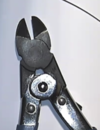Mr Nairn's tutorials Flashcards
(96 cards)
what is the index of orthodontic treatment need
- ranks malocclusion in terms of the significance of various occlusal traits for an individual’s health and perceived aesthetic impairment
- two components
- aesthetic component
- dental health component
what is this

Adams 64 pliers
what is this

Coil formers 65
what is this

wire cutters
what wire do we use in ortho
hard stainless steel
what is bending
rigid
what is manipulation
slowly following the curve
Problems with an overjet
- trauma
- aesthetic
- incompetant lips
- potential lip trap
What is the acronym used for designing URAs
ARAB
What does ARAB stand for
A: active component/s
R: retentive
A: anchorage
B: baseplate
What do we say for the active component
- component that will move the teeth through the application of force
- gauge of wire
what is the retentive component
- resistance to displacement forces
examples of retentive elements
- Adam’s clasps
- southend clasp
what are the 5 main displacement forces of a URA
- tongue
- gravity
- mastication
- talking
- the active component
What is anchorage
the resistance to unwanted tooth movement
3 functions of a base plate
- holds all components together
- helps with retention
- helps with anchorage
advantages of heat cure over self cure PMMA
- can control when it cures
- better polymerisation (all free monomer is used up, very little chance of allergic reaction)
- less shrinkage with heat cure
- stronger
disadvantage of heat cure PMMA
takes ages
so what is better, heat cure or self cure PMMA
heat cure is better but self care is satisfactory and a lot faster
what is the problem with anchorage
newton’s 3rd law
-
for every force there is an opposite and equal reaction
e. g. 6mm OJ, over 6 months, the gap should become zero
Gives a gap of 6mm between lateral and canine. The canine has moved 6mm distally ?? But based on newtons 3rd law, if they cannot move, instead of canines moving back, everything else has moved forward. Forces have gone into the baseplate instead of the canines and everything else moves forward. This is a disaster and why anchorage is a nightmare becauses the overjet will now be 12mm. If you do this, contact indemnity.
how do you prevent having problems with anchorage
- aim for 1mm of tooth movement per month
- on every visit
- measure the gap (monthly basis)
- measure the overjet (if the appliance is working the overjet shouldn’t move)
- don’t move too many teeth at once
Advantages of URAs
- tipping of teeth
- excellent anchorage
- generally cheaper than fixed
- shorter chairside time required
- OH easier to maintain
- Non-destructive to tooth surface
- less specialised training required to manage
- can be easily adapted for overbite reduction
- can achieve block movements
Disadvantages of URAs
- less precise control of tooth movement
- can be easily removed by patient
- generally only 1-2 teeth can be moved at one time
- specialist technical staff required to construct the appliances
- rotations very difficult to correct
What is the function of an adam’s clasp
- retentive component for removable appliances
- achieves retention by utilising mesial and distal undercuts














